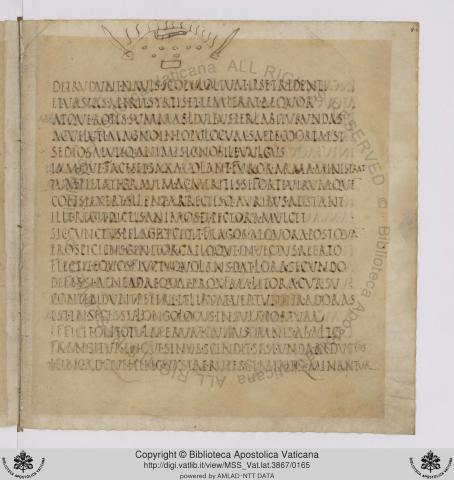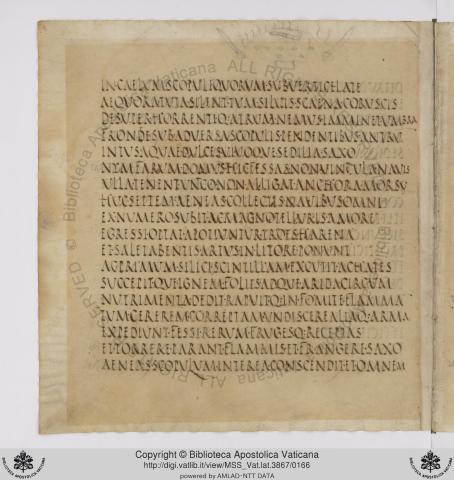Dēfessī Aeneadae quae proxima lītora cursū
contendunt petere, et Libyae vertuntur ad ōrās.
Est in sēcessū longō locus: īnsula portum
efficit obiectū laterum, quibus omnis ab altō160
frangitur inque sinūs scindit sēsē unda reductōs.
Hinc atque hinc vāstae rūpēs geminīque minantur
in caelum scopulī, quōrum sub vertice lātē
aequora tūta silent; tum silvīs scaena coruscīs
dēsuper, horrentīque ātrum nemus imminet umbrā.165
Fronte sub adversā scopulīs pendentibus antrum;
intus aquae dulcēs vīvōque sedīlia saxō,
nymphārum domus. Hīc fessās nōn vincula nāvēs
ūlla tenent, uncō nōn alligat ancora morsū.
Hūc septem Aenēās collēctīs nāvibus omnī170
ex numerō subit, ac magnō tellūris amōre
ēgressī optātā potiuntur Trōës harēnā
et sale tābentēs artūs in lītore pōnunt.
Ac prīmum silicī scintillam excūdit Achātēs
succēpitque ignem foliīs atque ārida circum175
nūtrīmenta dedit rapuitque in fōmite flammam.
Tum Cererem corruptam undīs Cereāliaque arma
expediunt fessī rērum, frūgēsque receptās
et torrēre parant flammīs et frangere saxō.
notes
Manuscripts: M 157-175, 176-179 | R 157-162, 163-179
The Trojans land in a sheltered spot and prepare a meal (Walpole).
157: defessi: de as a prefix is intensive (F-B). Aeneadae: “followers of Aeneas.” The patronymic is used in an extended sense (F-B). quae… petere: contendunt petere litora, quae (sunt) proxima (in) cursu (Cooper). quae proxima litora: sc. sunt. litora is a nominative case attracted into the relative clause (F-B) (AG 307b). “Strive to reach in their course the shores that are nearest” (Anthon). cursu: = rapidē, “quickly” as in 2.321 (Conington).
159: est: “there is.” The substantive verb often stands first in descriptions (F-B). secessu longo: “in a deep inlet.” portum efficit: “makes a perfect harbor.” efficit is stronger than facit. The island lies across the entrance of the inlet (F-B). As object of efficit understand eum referring to secessu or locus; portum is predicate accusative (Bennett).
160: quibus: the ablative, means of frangitur and scindit; “by which every wave from the deep is broken, and divides itself into the deep windings of the bay” (Frieze). ab alto: = veniens ab alto (Walpole).
161: sinus: may have two meanings: (1) a horizontal curve, and so a bay or indentation of the shore; (2) a vertical curve, and so an undulation, billow, or ripple (Page).
162: hinc atque hinc: “on this side and on this”; “on either side”; not hinc atque illinc, because the two points are conceived to be equally near to the spectator (Frieze). rupes: sc. sunt. minantur in caelum: “loom up toward heaven” (F-B).
164: tuta: seems to include the two notions, protected from the wind, and safe for ships (Conington). tum: “then too,” or “further,” introducing a fresh point in the description (F-B). silvis scaena coruscis: “a scene of shimmering woods.” silvis is an ablative of quality (AG 415). The scaena is properly the “scene” or back wall of a Roman stage, the rupes corresponding to the side walls of the theater. coruscis is used of the waving tree-tops gleaming in the sunlight (F-B). silvis curuscis is an ablative of quality or description (Frieze).
165: horrentique…: “and a grove overhangs, dark with gloomy shade.” Vergil carefully contrasts the dark grove with the sunny tree-tops. (F-B). “Bristling and quivering,” a typical example of the Vergilian economy of saying one thing by a word which itself suggests another thing also ... here the effect upon the spectator, who cannot help trembling too (Conway). nemus: added to scaena by way of epexegesis (Frieze).
166: fronte sub adversa: “under the brow (of the cliffs) facing one,” i.e., as one enters the harbor (F-B).
167: dulces: “fresh” (F-B). vivo sedilia saxo: “seats of living rock,” contrasted with artificial benches (Conway).
168: Nympharum domus: may be in either vague apposition to the two preceding lines, or in strict apposition to antrum (Conington). The Nymphs were often associated with grottoes and most frequently with springs of fresh water (Page). hīc: “here” (Carter). fessas navēs: by a natural personification the ships are regarded as living things (F-B).
169: non: = nulla (Comstock). morsu: the “toothed” anchor is thought of as biting into the ground (Carter).
170: collectis navibus: abl. abs. (Comstock).
172: optata: = quem optaverant, “which they had prayed for” (F-B).
173: sale tabentes: “drenched with brine”; tabentes is a strong word, suggesting defilement or pollution (F-B).
174: silici: dat. of separation (Comstock) (AG 381).
175: succepit: an archaic form for suscepit.The metaphor from infancy (“conceive, beget”) is continued in nutrimenta (“nourishment”), used of leaves, twigs, etc. (F-B). rapuit: used of rapid motion to and fro (F-B). circum: belongs with dedit in the next verse. Tmesis (Walpole).
177: Cererem: by metonymy for frumentum, the goddess of grain for the grain itself (F-B). Cerealia arma: the implements for preparing the grain for eating (Bennett).
178: fessi rerum: “weary of trial.” Poetic use of the genitive (F-B). receptas: “rescued” (F-B).
179: torrere et frangere: in preparing meal, the grain was commonly steeped, then parched, then crushed. Here the grain needed no steeping, being wet already (F-B). They roast their grain before they reduce it to meal, because it was usual to do so (see Georgics 1.267 nunc torrete igni fruges: nunc frangite saxo); and it was usual to do so because roast grain is less tough, more friable, more easily reduced into meal, that raw. It was not unusual to wet grain (perfusio, perfundere) before roasting, in order to increase the effect of the roasting. See Pliny, Natural History 18.98.1. (Henry)
vocabulary
defessus, -a, -um: wearied, tired, fatigued, 1.157. (dēfetīscō)
Aeneadēs, ae, m.: a son of Aeneas; pl., Aeneadae, ārum, followers of Aeneas, the Trojans, 1.565; Aeneadae, 3.18.
contendō, ī, tentus, 3, a.: to stretch completely; stretch, strain; strain the bow, 12.815; level the arrow, 5.513; shoot, 5.520; endeavor, strive, 1.158; contend, 4.108; hold, steer, 5.834; contend in skill of any kind.
Libya, ae, f.: Libya; northern Africa; by poetic license, Africa, 1.22, et al.
ōra, ae, f.: a margin, border, 12.924; coast, shore, 3.396; region, 2.91; rim, extremity, 10.477; pl., outline, compass, 9.528.
sēcessus, ūs, m.: a going apart; a retreat, retirement; a recess, 1.159. (sēcēdō)
portus, ūs, m.: a port, harbor, haven, 1.159, et al; (fig.), 7.598.
obiectus, ūs, m.: a throwing against; projection, opposition, 1.160. (obiciō)
altum, ī, n.: the deep; the lofty; the deep sea, the main, the deep, 1.3; the sky, heaven, air, 1.297; from far, far-fetched, remote, 8.395. (altus)
scindō, scidī, scissus, 3, a.: to cut asunder; split, 6.182; part, separate, divide, 1.161; tear, 9.478; (fig.), divide, 2.39.
reductus, a, um: reductus, a, um, retired, remote, solitary, 6.703; receding, 1.161. (redūcō)
vāstus, a, um: (adj.), empty, void, wild, waste, 9.323; vast, unbounded, 1.118; huge, enormous, immense, 3.647; deep-, vast-, sounding, 1.245.
rūpēs, is, f.: a rock, cliff, crag, ledge, freq.; quarry, 1.429. (rumpō)
geminus, a, um: (adj.), twin, 1.274, et al.; twofold, 6.203; double, two, 4.470; pl., geminī, ae, a, twin, 2.500; two, 1.162.
minor, ātus sum, 1, dep. n. and a.: to jut out, project; ascend, tower, 1.162; threaten, menace, 3.540. (minae)
scopulus, ī, m.: a projecting ledge of rock; a high cliff or rock, 1.180; crag, 1.45; ledge, reef, 1.145; detached rock, fragment of rock, 12.531.
vertex, icis, m.: a whirl; whirlpool, 7.567; vortex, 1.117; whirling column of flame, 12.673; the top, crown of the head, the head, 1.403; summit, top, 1.163; mountain summit, height, 3.679; ā vertice, from on high, from above, 1.114. (vertō)
lātē: (adv.), widely; far and wide, 1.21; on all sides, far around, 1.163; all over, 12.308. (lātus)
sileō, uī, 2, n. and a.: to be, keep, remain silent, 2.126; be hushed, calm, still, 1.164; w. acc., to pass over in silence; leave unmentioned, unsung, 10.793.
scaena, ae, f.: the stage of a theatre, 4.471; a sylvan scene, view, 1.164.
coruscus, a, um: adj. (coruscō), vibrating, tremulous, waving, 12.701; flashing, 1.164; gleaming, 2.172.
dēsuper: (adv.), from above; above, 1.165.
horrēns, entis: bristling, bristly, 1.634; rough, roughening, 1.165; fierce, 10.237. (horreō)
āter, tra, trum: (adj.), black; dark, gloomy, 1.60, et al.; smoky, lurid, 7.456; 4.384; clotted, dark, 3.622; soiled, blackened, 2.272; (fig.), sad, fatal, 6.429; venomous, deadly; of the odor of smoke, 12.591.
immineō, 2, n.: to rest over; overhang, 1.165; to be at hand; approach, 9.515.
pendeō, pependī, 2, n.: to hang, foll. by abl. alone or w. prep., 2.546, et al.; 5.511; be suspended, 1.106; cling, 9.562; bend, stoop forward, 5.147; (meton.), linger, delay, 6.151; listen, hang upon, 4.79.
antrum, ī, n.: a cave, cavern, grotto, 1.166.
intus: (adv.), within, 1.294, et al. (in)
vīvus, a, um: adj. (vīvō), alive, living, 6.531; lifelike, 6.848; immortal, 12.235; of water, living, running, pure, 2.719; of rock, natural, unquarried, living, 1.167.
sedīle, is, n.: a bench, seat, 1.167. (sedeō)
nympha, ae, f.: a bride, a maiden; a nymph, one of the inferior deities, presiding over fountains, woods, etc., 1.71, et al.
uncus, a, um: (adj.), hooked, crooked, 1.169; talon-shaped, hooked, 3.217.
adligō, āvī, ātus, 1, a.: to tie or bind to; hold fast, hold, 1, 169; constrain, confine, 6, 439.
ancora, ae, f.: an anchor, 1.169.
morsus, ūs, m.: a biting; eating, 3.394; tooth, 7.112; fang, 2.215; gripe, hold, 12.782; fluke, 1.169. (mordeō)
septem: (num. adj.), seven, freq.
Aenēās, ae, m.: 1. A Trojan chief, son of Venus and Anchises, and hero of the Aeneid, 1.92. 2. Aenēās Silvius, one of the Alban kings, 6.769.
subeō, iī, itus (p. subiēns, euntis), 4, n. and a.: to go or come under, into, or up to; alone, or with acc. and prep., or with dat.; without a case, come up, 2.216; go under, bend, stoop down under, 10.522; come after; follow, 2.725; take one's place, 12.471; enter, 1.171; come into or upon the mind, suggest itself, occur, 2.560; with acc. and prep., go, advance towards, 8.359; with dat., come or go up to, down to, into, 5.203; succeed to, 5.176; come after, follow, 10.371; with acc., approach, enter, 1.400; go under a burden, bear, with abl. of instrument, 2.708; go under the yoke, draw, 3.113; enter the mind of, strike, occur to, 9.757; approach, reach, 3.512; approach, 7.22; meet, encounter, 10.798; attack, 9.344.
atque, or ac: (conj.), and in addition, or and besides; and, as well, and indeed, and, 1.575; freq.; even, 2.626; in comparisons, as, 4.90; than, 3.561.
optātus, a, um: desired, longed for, much desired, 1.172; (adv.), optātō, according to one's wish; in good time, 10.405.
potior, ītus sum, 4, dep. n.: to become master or possessor of; get, take possession, w. abl., 3.56; enjoy, 4.217; seize, 12.642; win, 9.363; achieve, execute, 6.624; gain, reach, 1.172. (potitur, 3.56; 4.217) (potis)
Trōes, m.: (subst.), the Trojans, 1.30, et al. (Tros, one of the kings of Troy)
harēna, ae, f.: sand, 1.112; sandy shore, strand, 1.540; sandy ground, arena; space for races; an arena, 5.336.
sāl, salis, m.: salt; brine, salt water, 1.173; (meton.), the sea, 1.35.
tābeō, 2, n.: to melt; drip, be drenched, 1.173; to waste away, be wan, 12.221.
artus, ūs, m.: a joint of the body of man or beast, 5.422; a limb, 2.173, et al.; part, member, 6.726; frame, body, 9.490. (generally in the pl., except in later writers)
silex, icis, m. and f.: a hard stone, flint, 1.174; rock, 6.602; crag, 6.471.
scintilla, ae, f.: a spark, 1.174.
excūdō, cūdī, cūsus, 3, a.: to strike out, 1.174; beat out, mold, 6.847.
Achātēs, ae, m.: Achates, a companion of Aeneas, 1.174, et al.
suscipiō, cēpī (succēpī, 1.175), ceptus, 3, a.: to take up, 4.391; receive, catch, 1.175; conceive, beget, 4.327; undertake, 6.629; reply, 6.723; to take up the new-born child; (pass.), to be born, 4.327. (sub and capiō)
folium, iī, n.: a leaf, 1.175.
āridus, a, um: adj. (āreō), dry, parched, 5.200; thirsty.
circum: (adv.), about, around; (prep. with acc.), around, about.
nūtrīmentum, ī, n.: nourishment; fuel, 1.176. (nūtriō)
fōmes, itis, m.: kindling stuff; fuel, 1.176. (foveō)
Cerēs, eris, f.: daughter of Saturn and Ops, and goddess of agriculture; (meton.), corn, grain, 1.177; bread, 1.701; cake, loaf, 7.113; Cerēs labōrāta, bread, 8.181.
Cereālis, e: adj. (Cerēs), of Ceres; pertaining to Ceres or to grain; Cereālia arma, utensils for preparing grain or making bread; instruments of Ceres, 1.177.
expediō, īvī or iī, ītus, 4, a.: to make the foot free; to extricate, disentangle; bring forth, get ready, 1.178; seize, use, 5.209; serve, 1.702; unfold, describe, disclose, 3.379, 460; declare, 11.315; pass. in middle sig., make one’s way out, escape, 2.633. (ex and pēs)
frūx, frūgis, f.: (found usually in the pl., frūgēs, um) fruit, of the ground and of trees; fruit of the ground; corn, 1.178; wheaten meal, sacrificial grits, cake, 2.133; herbs, 6.420. (fruor)
torreō, uī, tostus, 2, a. and n.: to burn, scorch, roast, parch, 1.179; rush, roll, 6.550; of a river bank, 9.105; p., torrēns, entis, subst., a torrent, 7.567.



